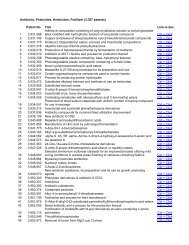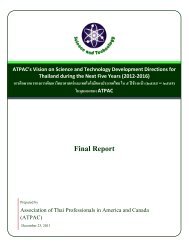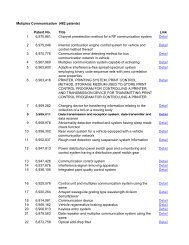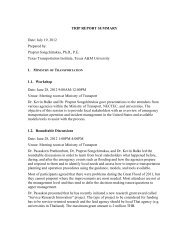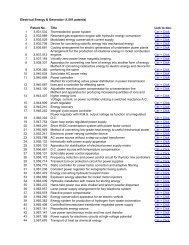Presentation
Presentation
Presentation
You also want an ePaper? Increase the reach of your titles
YUMPU automatically turns print PDFs into web optimized ePapers that Google loves.
Methi Wecharatana<br />
New Jersey Institute of Technology<br />
1
Development that meets the needs of the<br />
present generation without<br />
compromising the needs of the future<br />
generation<br />
It contains two key concepts: Needs of<br />
the world’s poor and the limitations of<br />
natural resources and environment<br />
imposed by the state of technology and<br />
social organization<br />
2
Economic Development<br />
poverty eradication<br />
Social Development<br />
active participation of minority<br />
education<br />
good governance<br />
Protection of Environment and Natural<br />
Resources<br />
prevent environmental degradation and<br />
patterns of unsustainable development<br />
3
Identified by former UN Secretary General<br />
Kofi Annan:<br />
Water and sanitation<br />
Energy<br />
Health<br />
Agriculture<br />
Biodiversity protection and ecosystem<br />
management<br />
4
Studies conducted by National Academy<br />
of Sciences and Engineers, known as the<br />
“American Climate Choices (ACC)”<br />
July 2010<br />
About greenhouse gas and carbon<br />
emissions, National Research Council<br />
(NRC) reports concluded that strong<br />
evidence of climate change underscores<br />
the need to limit emissions and adapt to<br />
inevitable impacts.<br />
5
A strong, credible body of scientific<br />
evidence shows that<br />
climate change is occurring,<br />
is caused largely by human activities,<br />
and<br />
poses significant risks for a wide range<br />
of human and natural systems<br />
6
Meeting internationally discussed<br />
targets for limiting atmospheric<br />
greenhouse gas concentrations will<br />
require major departure from business<br />
as usual in how the world uses and<br />
produces energy<br />
7
Adaptation to climate change calls for a<br />
new paradigm –one that considers a<br />
variety of possible future climate<br />
conditions, some well outside the realm<br />
of past experience<br />
“The 1:100 year storm event of yesterday<br />
may now be a 1:20 year event.”<br />
8
Sea level rise<br />
Globally, the sea level is projected to rise 7 to<br />
23 inches<br />
Heat Waves<br />
Absent the effective reductions in GHG<br />
emissions, projected temperature rise by the<br />
end of the this century ranges from a low of 4<br />
to 7 o F to a high of 7 to 11 o F (These are<br />
enormous increases!)<br />
11
Increasingly Intense Precipitation<br />
Warmer temperatures lead to more<br />
evaporation, hence drought and lower water<br />
levels in some area, whereas more intense<br />
storms and flooding in other sectors.<br />
Consequently, hydrological models and<br />
computations of 100-year flood plain must be<br />
revised to reflect tomorrow’s precipitation<br />
intensities, affecting design and planning of<br />
all existing and future critical infrastructures.<br />
12
Increasingly intense hurricanes<br />
Some evidence shows that rising<br />
temperatures in the ocean, notably in<br />
the Gulf of Mexico and in the Pacific,<br />
fuel stronger hurricanes and cyclones<br />
(not necessarily more frequent storms,<br />
but deadlier storms with higher wind<br />
speeds and heavier precipitation.<br />
13
Arctic Warming<br />
Global warming is most apparent at high<br />
northern latitudes, that is, in the Arctic.<br />
Temperatures in Alaska has already risen 3<br />
to 5 o F, twice as much as in the main 48 states<br />
Anticipated thawing of as much as 90 percent<br />
of the permafrost will result in the<br />
displacement of pavements, runways, rail<br />
lines, pipelines, buildings, and bridges<br />
14
Sea Level Rise<br />
Build or enhance levees and dikes to resist<br />
higher sea levels and storm surges<br />
Elevate critical infrastructure<br />
Abandon or relocate coastal highways, rail<br />
lines, bridges, and communities<br />
Provide good evacuation routes and<br />
operational plans<br />
Reduce development in at-risk coastal<br />
regions<br />
15
Heat Waves<br />
Support research on new, more heat-resistant<br />
materials for paving and bridge decks<br />
Replace and/or reconstruct highway and<br />
bridge expansion joints<br />
Increase the length of airport runways to<br />
compensate for lower air densities<br />
Revisit standards for construction workers<br />
exposed to high temperatures<br />
16
Increased Storm Intensity<br />
Revise hydrologic storm and flood frequency<br />
maps<br />
Develop new design standards for hydraulic<br />
structures<br />
Reinforce at-risk structures, particularly to<br />
protect against scouring of bridge piers<br />
Encourage better land-use planning for flood<br />
plains<br />
17
Stronger Hurricanes and Cyclones<br />
Move critical infrastructure inland<br />
Reinforce and/or build more robust,<br />
resilient structures<br />
Design for greater storm surges<br />
Strengthen and elevate port facilities<br />
18
Arctic Warming<br />
Identify areas and infrastructure that<br />
will be damaged by thawing<br />
permafrost<br />
Develop new approaches to foundation<br />
design<br />
Reinforce, protect, or move seaside<br />
villages<br />
19
Measures to reduce GHG emissions could<br />
include:<br />
underground carbon sequestration,<br />
increased biomass uptake, and<br />
geo-engineering to limit amount of incoming solar<br />
radiation.<br />
Legislative actions to encourage mitigation<br />
measures could include:<br />
carbon taxes;<br />
cap and trade markets; and<br />
new CAFÉ (corporate average fuel economy)<br />
standards for vehicles<br />
20
Petroleum 37%<br />
Natural Gas 24%<br />
Coal 23%<br />
Nuclear 9%<br />
Renewable 7%<br />
22
The U.S. Electric Power sector<br />
generates 2.4 billion metric tons of<br />
carbon emissions<br />
This equals to 40% of all CO 2<br />
emissions in the U.S.<br />
23
Updated August 2009<br />
NREL is a national laboratory of the U.S. Department of Energy Office of Energy Efficiency and Renewable Energy operated by the Alliance for Sustainable Energy, 24LLC
U.S. Renewable Resources<br />
Resource Solar<br />
PV/CSP)<br />
Theoreti<br />
cal<br />
Potential<br />
206,000<br />
GW (PV)<br />
11,100G<br />
W (CSP)<br />
Wind Geotherma<br />
l<br />
8,000<br />
GW<br />
(onshore<br />
)<br />
2,200<br />
GW<br />
(offshore<br />
to 50<br />
nm)<br />
39 GW<br />
(conventio<br />
nal) 520<br />
GW (EGS)<br />
4 GW<br />
(coproduced)<br />
Water<br />
Power<br />
Biopower<br />
140 GW 78 GW<br />
25
Including Transmission Lines<br />
Resource Solar<br />
PV/CSP)<br />
Theoreti<br />
cal<br />
Potential<br />
206,000<br />
GW (PV)<br />
11,100G<br />
W (CSP)<br />
Wind Geotherma<br />
l<br />
8,000<br />
GW<br />
(onshore<br />
)<br />
2,200<br />
GW<br />
(offshore<br />
to 50<br />
nm)<br />
39 GW<br />
(conventio<br />
nal) 520<br />
GW (EGS)<br />
4 GW<br />
(coproduced)<br />
Water<br />
Power<br />
Biopower<br />
140 GW 78 GW<br />
26
U.S. Concentrating Solar Resource<br />
28
U.S. Wind Resource<br />
29
U.S. Biomass Resource<br />
30
In the carbon-energy realm, it is possible<br />
to burn natural gas and produce only<br />
half the CO 2 generated by burning coal,<br />
and two-thirds the CO 2 produced by<br />
burning oil<br />
Burning biomass also generates CO 2 but<br />
not as much as fossil fuels do<br />
Good, but not good enough to limit GHG<br />
to 450 ppm<br />
31
Sunlight showers the planet with<br />
more energy in one hour than the<br />
world’s population consumes in an<br />
entire year<br />
The potential that awaits the right<br />
technology is staggering<br />
32
Between 1990 and 2000, wind energy<br />
output in the U.S. doubled, increasing<br />
from 2.8 billion kWh to 5.6 billion kWh<br />
Just 8 years later, in 2008, output had<br />
grown nearly tenfold to 52 billion kWh<br />
On a typical day, that’s enough electricity<br />
to power more than 10 million homes<br />
42
Wind energy from the Great Plains and<br />
Solar energy from the Southwest could<br />
provide energy to the whole U.S.<br />
As much as 300,000 megawatts of green<br />
power (an equivalent of 300 coal-fire<br />
power plants) are being stalled due to<br />
lack of high-voltage transmission lines<br />
There is a need for a “green power<br />
superhighway system”<br />
43
Hydro sources in 2008 churned out about 248<br />
billion kWh<br />
There are more than 5,500 sites that could<br />
increase output by approximately 40 percent<br />
U.S. geothermal power plants produced almost<br />
15 billion kWh<br />
These numbers are small fraction of the total<br />
U.S. Electricity Generation in 2008, which totaled<br />
to more than 4 trillion kWh, and most of which<br />
are from the coal-fired power plants<br />
44
Advanced PC (Pulverized Coal) and SPCC<br />
(Supercritical Pulverized Clean Coal)<br />
Technology<br />
NGCC (Natural Gas Combined Cycle)<br />
Technology<br />
IGCC (Integrated Gasification Combined<br />
Cycle) Technology<br />
Lowest Sulfur emissions from a coal plant<br />
Lowest NO X permitted plant using bituminous coals<br />
Specific carbon emissions to the atmosphere<br />
(kg C/net kWh) of IGCC+S are only about 1/5 of<br />
NGCC<br />
45
33% less NO x<br />
75% less SO x<br />
40% less PM 10 (10-micron<br />
particulate matter)<br />
30% less water<br />
Superior Hg removal<br />
CO 2 capture ready<br />
46
Coal is gasified to produce synthetic gas (syngas)<br />
Pollutants are removed from the syngas, then<br />
electricity is generated using a combined cycle,<br />
consisting of the following three steps:<br />
A gas turbine-generator burns the syngas<br />
Heat from the gasification and the exhaust heat from<br />
the gas turbine are used to create steam<br />
The steam is used to power a steam turbine-generator<br />
Carbon dioxide sequestration is applicable<br />
47
CCS technologies allow emissions of carbon<br />
dioxide to be captured (by compression) and<br />
stored, preventing them from entering<br />
atmosphere.<br />
The cost of current CCS to capture and store<br />
CO 2 emitted from a new coal-fired power plant<br />
can add 30-40% to the capital cost, and<br />
approximately 60-80% to the operating costs of<br />
the plant.<br />
About 2/3 of these increased costs are<br />
attributed to the CO 2 capture system<br />
48
If the climate legislation is implemented,<br />
U.S. electric power companies would<br />
have to pay about $20 for each ton of<br />
carbon dioxide their plants produce<br />
A coal-burning power plant fitted with<br />
CCS technologies would face recurring<br />
costs of about $125 per ton of CO 2 it<br />
buried underground<br />
49
Huaneng Group, China’s largest power<br />
producer, is taking the lead<br />
Its Beijing Cogeneration Power Plant<br />
shows a CCS system for collecting and<br />
compressing CO 2 from variety of waste<br />
gases<br />
The CO 2 is then sold to a bottler that uses it<br />
to carbonate soft drinks<br />
50
Duke Energy has acquired a CCS technology<br />
licensing from China Huaneng group, which<br />
has the largest CCS operation at its power plant<br />
in Shanghai<br />
Peabody Energy, U.S. largest coal producer,<br />
bought a 6% stake in GreenGen, a $1 billion<br />
coal-fired power plant in Tianjing with CCS<br />
technology<br />
51
“China can become the world’s leading clean-coal<br />
provider”, said Peabody CEO Gregory H. Boyce<br />
It has R&D Center for carbon management<br />
technologies<br />
Recently, China has deployed an advanced<br />
process called TRIG (Transport Integrated<br />
Gasification), which is especially good at<br />
neutralizing low-grade, CO 2-laden coal<br />
52
The world wastes a startling 57% of its energy<br />
Coal plants lose about 65% of their energy at<br />
generation<br />
Throwing away one aluminum can wastes as<br />
much energy as if that can was ½ full of gasoline,<br />
and Americans throw away enough aluminum<br />
cans to rebuild the nation’s commercial air fleet<br />
every three months<br />
53
When electronic gadgets are not on, “vampire<br />
electricity” runs through plugs, annually<br />
wasting 0.25% if the nation’s energy –a small<br />
figure that translates into $4 billion in energy<br />
Heating, lighting and air conditioning account<br />
for up to 70 percent of energy usage in most<br />
commercial buildings<br />
Building consumes about 40% of the world’s<br />
energy<br />
Weatherizing alone could cut energy use in<br />
buildings by as much as 30 percent<br />
54
Fuel (Quadrillion Btu)<br />
Coal 20.66 Fossil<br />
Fuels<br />
Natural Gas 7.07<br />
Petroleum 0.69<br />
Other Gases 0.18<br />
Nuclear<br />
Electric Power<br />
Renewable<br />
Energy<br />
8.21<br />
4.28<br />
Other 0.18<br />
28.6<br />
Total Fuel 41.27<br />
Electricity (Quadrillion Btu)<br />
Conversion Losses 26.71<br />
Gross Generation of<br />
Electricity<br />
**Retail Sales 12.51<br />
(Only 30% of total<br />
fuel used)<br />
14.56<br />
55
Gross<br />
Generation<br />
of electricity<br />
14.56<br />
Plant Use<br />
0.73<br />
Net<br />
Generation<br />
of Electricity<br />
13.83<br />
Transmission & Distribution<br />
Losses 1.31<br />
Retail Sales<br />
12.51<br />
Residential<br />
4.62<br />
Commercial<br />
4.44<br />
Industrial<br />
3.42<br />
56
U.S. Energy demands will triple by 2050<br />
What will provide adequate energy yet reduce<br />
greenhouse gas emissions, and do it quickly?<br />
The answer might lie in the atom -Nuclear<br />
Energy<br />
Nuclear provides clean, constant, scalable<br />
electricity with minimum carbon emissions<br />
57
A small amount of nuclear fuel releases<br />
enormous energy<br />
One pound of uranium 235 has more than<br />
two-million times the energy content of a<br />
pound of coal<br />
France gets 80% of its electricity from<br />
nuclear power plants<br />
58
One gigawatt of nuclear energy for a year<br />
generates 20 tons of waste –that’s two dry-cask<br />
storage containers – and no carbon dioxide<br />
One gigawatt of energy from coal for a year<br />
uses 2.9 million tons of coal and produces eight<br />
million tons of carbon dioxide, plus no end of<br />
slurry, fly ash and atmospheric mercury, plus<br />
sulfur dioxide from unscrubbed plants<br />
59
Small modular reactors can be manufactured<br />
in a central factory, under control conditions,<br />
resulting in identical devices that –because<br />
they are duplicates –facilitate maintenance<br />
Utilities could simply yank small reactors like<br />
batteries and plug in new ones<br />
Small modular reactors do not take much<br />
time to build versus old large reactors<br />
Small reactors would also be less expensive<br />
60
Each time we click on a Web site to send an email<br />
or do a search, the request ends up at one<br />
of the world’s 10,000 data centers that store,<br />
transfer and complete the Web’s transactions.<br />
Each click requires a small amount of<br />
electricity, and it adds up quickly<br />
Data centers uses 1.5% of U.S. electricity, and<br />
are responsible for releasing 70 billion tons of<br />
carbon dioxide annually<br />
61
With power bills total to millions of dollars a<br />
year, electricity is the largest expense for the<br />
typical data center, making it an attractive<br />
target for aggressive cost-cutting<br />
The Green Grid, a consortium of most<br />
computer- and web-related companies, i.e.<br />
AMD, Dell, Intel, IBM, HP, Microsoft, Oracle,<br />
etc., develops tools to quantify and compare<br />
power use for data centers and publish a<br />
design guide that details the industry’s best<br />
practices<br />
62
Some data centers today run at only 30 percent<br />
efficiency while properly designed and<br />
operated facilities can have an efficiency of<br />
about 82 percent<br />
This not only cuts the expenses, but it keeps<br />
hundreds of thousands of tons of carbon<br />
dioxide from the atmosphere.<br />
How efficient is your IT facilities and data<br />
centers?<br />
63
Annual Carbon emissions of three leading<br />
computer firms:<br />
Apple (10.2 million tons)<br />
HP (8.4 million tons)<br />
Dell (471,000 tons<br />
Note that both HP and Dell are larger than Apple<br />
Apple is shipping million of power-hungry<br />
products with toxic chemicals in them<br />
Key sources: polyvinyl chlorides (PVCs) and<br />
bromide flame retardants (BFRs) in Apple’s<br />
devices<br />
64
A state-of-the-art energy storage system coupled<br />
with the GE’s Smart Grid technologies<br />
A partnership project launched in September 2010 in<br />
Bella Coola, a remote town in Canada, which<br />
depends on the use of diesel generators for power<br />
generation<br />
The town used 200,000 liters of diesel and generated<br />
600 tons of GHG annually<br />
This is a partnership project between BC Hydro, GE<br />
and Powertech, and is supported by Province of<br />
B.C. and Sustainable Development Technology<br />
Canada<br />
66
Use of high-performance, high-volume fly<br />
ash concrete as sustainable products for<br />
cement and concrete industry<br />
The concrete mixtures contain more than<br />
50% by weight of fly ash, a by-product<br />
from the coal-fired power utilities which is<br />
sometimes considered as waste<br />
68
The incorporation of high volume fly ash<br />
in concrete<br />
reduces water demand,<br />
improves workability,<br />
minimizes cracking due to thermal and<br />
drying shrinkage, and<br />
enhances durability to reinforcement<br />
corrosion, sulfate attack, and alkali-silica<br />
expansion<br />
69
• Annually, in the U.S. there are more than 50<br />
million tons of unused fly ash, causing enormous<br />
disposal cost and environmental problems<br />
• The unused fly ashes in landfills are subjected to<br />
weathering, and leachate sometimes leads to<br />
groundwater contamination<br />
• In Thailand, there are more than 30 million tons of<br />
weathered fly ash at Mae Moh alone<br />
• Beneficial utilization of these industrial byproducts<br />
would help sustain both the utility and<br />
the cement industry<br />
70
FHWA, EPA, ACI, and AASHTO have<br />
been promoting the use of recycled<br />
concrete aggregates in new concrete<br />
construction<br />
Each year, many existing structures, such<br />
as buildings, bridges, and highways were<br />
demolished to make way for new<br />
structures<br />
71
FHWA and many State DOTs are investing on<br />
research and development of standards and<br />
design guidelines for the use of recycled<br />
concrete and recycled asphalt aggregates for<br />
highway pavements and structures<br />
These concrete and asphalt materials can be<br />
effectively reused, saving a lot of virgin<br />
materials and eliminate many environmental<br />
problems<br />
72
Use of Recycled Materials in U.S. Highways<br />
Byproduct<br />
Materials<br />
Produced<br />
Blast Furnace<br />
Slag<br />
Production(million<br />
metric tons)<br />
Recycled in Highway<br />
Applications (million metric<br />
tons)<br />
14 12.6 Concrete<br />
Applications<br />
Coal Bottom Ash 14.5 4.4 Asphalt, Base<br />
Coal Fly Ash 53.5 14.6<br />
Foundry Sands 9 to 13.6 ?<br />
Cement Production,<br />
Structural Fill<br />
Flowable Fill,<br />
Asphalt<br />
Cement Kiln Dust 12.9 8.3 Stabilizer<br />
Bottom Ash 8 Small Amounts Asphalt, Base<br />
Nonferrous Slags 8.1 ? Base, Asphalt<br />
Steel Slags ? 7.5<br />
Recycled Asphalt<br />
Pavement<br />
Reclaimed<br />
Concrete<br />
Base, Asphalt,<br />
Concrete<br />
41 33 Asphalt, Base<br />
? ? Base, Concrete<br />
83
Establish<br />
a Research Center<br />
for<br />
Beneficial Utilization of<br />
Industrial Byproducts<br />
84
Sustainable Development (SD) and<br />
Corporate Social Responsibility (CSR) are<br />
basic principles towards the balance of living<br />
and nature<br />
Keeping in mind that it is not only for us but,<br />
more importantly, for the next generation<br />
It has a lot to do with Research and<br />
Development, a different way of living and<br />
doing business for a better quality of life<br />
85



